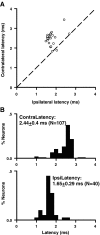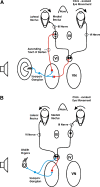Acoustic clicks activate both the canal and otolith vestibulo-ocular reflex pathways in behaving monkeys
- PMID: 19626369
- PMCID: PMC2774411
- DOI: 10.1007/s10162-009-0178-7
Acoustic clicks activate both the canal and otolith vestibulo-ocular reflex pathways in behaving monkeys
Abstract
Acoustic activation of the vestibular system has been well documented in humans and animal models. In the past decade, sound-evoked myogenic potentials in the sternocleidomastoid muscle (cVEMP) and the extraocular muscles (oVEMP) have been extensively studied, and their potentials as new tests for vestibular function have been widely recognized. However, the extent to which sound activates the otolith and canal pathways remains controversial. In the present study, we examined this issue in a recently developed nonhuman primate model of acoustic activation of the vestibular system, i.e., sound-evoked vestibulo-ocular reflexes (VOR) in behaving monkeys. To determine whether the canal and otolith VOR pathways are activated by sound, we analyzed abducens neurons' responses to clicks that were delivered into either ear. The main finding was that clicks evoked short-latency excitatory responses in abducens neurons on both sides. The latencies of the two responses, however, were different. The mean latency of the contralateral and ipsilateral abducens neurons was 2.44 +/- 0.4 and 1.65 +/- 0.28 ms, respectively. A further analysis of the excitatory latencies, in combination with the known canal and otolith VOR pathways, suggests that the excitatory responses of the contralateral abducens neurons were mediated by the contralateral disynaptic VOR pathways that connect the lateral canal to the contralateral abducens neurons, and the excitatory responses of the ipsilateral abducens neurons were mediated by the ipsilateral monosynaptic VOR pathways that connect the utricle to the ipsilateral abducens neurons. These results provide new insights into the understanding of the neural basis for sound-evoked vestibular responses, which is essential for developing new tests for both canal and otolith functions in humans.
Figures





Similar articles
-
Sound-Evoked Responses in the Vestibulo-Ocular Reflex Pathways of Rats.Front Neurosci. 2021 Oct 14;15:741571. doi: 10.3389/fnins.2021.741571. eCollection 2021. Front Neurosci. 2021. PMID: 34720863 Free PMC article.
-
Input-output functions of vestibular afferent responses to air-conducted clicks in rats.J Assoc Res Otolaryngol. 2014 Feb;15(1):73-86. doi: 10.1007/s10162-013-0428-6. Epub 2013 Dec 3. J Assoc Res Otolaryngol. 2014. PMID: 24297262 Free PMC article.
-
Perspectives for the comprehensive examination of semicircular canal and otolith function.Biol Sci Space. 2001 Dec;15(4):393-400. doi: 10.2187/bss.15.393. Biol Sci Space. 2001. PMID: 12101365 Review.
-
Physiological and behavioral identification of vestibular nucleus neurons mediating the horizontal vestibuloocular reflex in trained rhesus monkeys.J Neurophysiol. 1992 Jul;68(1):244-64. doi: 10.1152/jn.1992.68.1.244. J Neurophysiol. 1992. PMID: 1517823
-
Ontogenetic Development of Vestibulo-Ocular Reflexes in Amphibians.Front Neural Circuits. 2016 Nov 8;10:91. doi: 10.3389/fncir.2016.00091. eCollection 2016. Front Neural Circuits. 2016. PMID: 27877114 Free PMC article. Review.
Cited by
-
Effects of high intensity noise on the vestibular system in rats.Hear Res. 2016 May;335:118-127. doi: 10.1016/j.heares.2016.03.002. Epub 2016 Mar 10. Hear Res. 2016. PMID: 26970474 Free PMC article.
-
Differential Activation of Canal and Otolith Afferents by Acoustic Tone Bursts in Rats.J Assoc Res Otolaryngol. 2022 Jun;23(3):435-453. doi: 10.1007/s10162-022-00839-1. Epub 2022 Apr 4. J Assoc Res Otolaryngol. 2022. PMID: 35378621 Free PMC article.
-
Grey matter activation by caloric stimulation in patients with unilateral peripheral vestibular hypofunction.Neuroradiology. 2019 May;61(5):585-593. doi: 10.1007/s00234-019-02194-0. Epub 2019 Mar 16. Neuroradiology. 2019. PMID: 30877333
-
Reply to the Commentary on Luis et al. "Spontaneous plugging of the horizontal semicircular canal with reversible canal dysfunction and recovery of vestibular evoked myogenic potentials".Otol Neurotol. 2014 Feb;35(2):379-83. doi: 10.1097/MAO.0000000000000198. Otol Neurotol. 2014. PMID: 24448300 Free PMC article. No abstract available.
-
Association between hearing loss and saccular dysfunction in older individuals.Otol Neurotol. 2012 Dec;33(9):1586-92. doi: 10.1097/MAO.0b013e31826bedbc. Otol Neurotol. 2012. PMID: 23064383 Free PMC article.
References
-
- {'text': '', 'ref_index': 1, 'ids': [{'type': 'DOI', 'value': '10.1152/jn.00047.2004', 'is_inner': False, 'url': 'https://doi.org/10.1152/jn.00047.2004'}, {'type': 'PubMed', 'value': '15212435', 'is_inner': True, 'url': 'https://pubmed.ncbi.nlm.nih.gov/15212435/'}]}
- Angelaki DE. Eyes on target: what neurons must do for the vestibuloocular reflex during linear motion. J. Neurophysiol. 92(1):20–35, 2004. - PubMed
-
- {'text': '', 'ref_index': 1, 'ids': [{'type': 'PubMed', 'value': '7251295', 'is_inner': True, 'url': 'https://pubmed.ncbi.nlm.nih.gov/7251295/'}]}
- Bahill AT, Allan Brockenbrough A, and Troost BT. Variability and development of a normative data base for saccadic eye movements. Invest. Ophthalmol. Vis. Sci. 21(1 Pt 1):116–125, 1981. - PubMed
-
- {'text': '', 'ref_index': 1, 'ids': [{'type': 'DOI', 'value': '10.1016/0006-8993(69)90189-9', 'is_inner': False, 'url': 'https://doi.org/10.1016/0006-8993(69)90189-9'}, {'type': 'PubMed', 'value': '5344396', 'is_inner': True, 'url': 'https://pubmed.ncbi.nlm.nih.gov/5344396/'}]}
- Baker RG, Mano N and Shimazu H. Postsynaptic potentials in abducens motoneurons induced by vestibular stimulation. Brain Res. 15(2):577–580, 1969. - PubMed
-
- {'text': '', 'ref_index': 1, 'ids': [{'type': 'PubMed', 'value': '8747205', 'is_inner': True, 'url': 'https://pubmed.ncbi.nlm.nih.gov/8747205/'}]}
- Broussard DM, DeCharms RC and Lisberger SG. Inputs from the ipsilateral and contralateral vestibular apparatus to behaviorally characterized abducens neurons in rhesus monkeys. J. Neurophysiol. 74:2445–59, 1995. - PubMed
-
- {'text': '', 'ref_index': 1, 'ids': [{'type': 'PubMed', 'value': '1479453', 'is_inner': True, 'url': 'https://pubmed.ncbi.nlm.nih.gov/1479453/'}]}
- Broussard DM and Lisberger SG. Vestibular inputs to brain stem neurons that participate in motor learning in the primate vestibuloocular reflex. J. Neurophysiol. 68:1906–1909, 1992. - PubMed
Publication types
MeSH terms
Grants and funding
LinkOut - more resources
Full Text Sources
Miscellaneous

